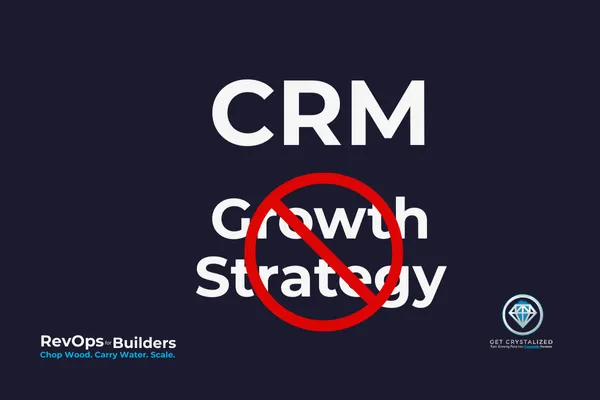
RevOps Reality Check: Why CRM Isn’t a Growth Strategy | Crystalized Insights Blog
RevOps Reality Check: CRM Isn’t a Growth Strategy
Every founder hears the same advice: “You need a CRM.”
But here’s the truth: a CRM doesn’t create growth.
It doesn’t find your ideal customers.
It doesn’t clarify your value proposition.
It doesn’t fix a broken sales process.
At best, it reflects what’s already happening in your business.
At worst, it becomes a glorified address book.
So, what should founders really expect from a CRM?
The Real Job of a CRM
A CRM is valuable — but not for the reasons vendors usually sell you.
The real job of a CRM is to:
Track how leads move through your system.
Show you which sources actually convert into customers.
Surface red flags when deals or customers stall.
In short: a CRM gives you visibility. It’s a mirror, not a magic wand.
How CRM Influences CAC
Every founder eventually asks: “How much does it really cost to win a customer?”
That’s Customer Acquisition Cost (CAC).
Your ad platform might show you cost per click. Your bank account shows you dollars spent. But only your CRM ties it all together:
Which sources produced actual customers.
How long it took them to convert.
Where deals slowed down or dropped off.
If you’re not tagging and tracking inside your CRM, you’re guessing at CAC — and that’s a dangerous place to scale from.
The RevOps View: Connecting the Dots
RevOps looks at CRM differently. It’s not “just software.” It’s connective tissue that threads across your business:
Marketing → Sales: Are the leads you’re generating actually closing?
Sales → Onboarding: Are customers moving smoothly into delivery?
Onboarding → Retention: Are early engagement red flags visible before churn hits?
A CRM only becomes powerful when it helps you connect these dots.
How to Supercharge a CRM with RevOps
Here’s where most founders leave money on the table: they use their CRM in isolation. Marketing lives in one tool, sales in another, operations in spreadsheets. None of it talks.
RevOps flips that. Instead of looking at ads, email, and outreach in silos, you thread the data into one system. That’s when a CRM stops being an address book and starts becoming a growth engine.
When your CRM is part of a cohesive RevOps setup, you can:
Compare Paid vs. Organic Campaigns in One Place
See not just how much you spent, but whether that LinkedIn post, podcast interview, or referral campaign actually turned into customers.Track Full-Journey Attribution
Go beyond “last click.” Watch how a lead discovered you, engaged over time, and finally became a paying customer.Calculate True Marketing ROI
Instead of guessing which activities are working, you can finally connect spend and effort to real revenue.
This is how founders move from gut decisions to confident scaling.
Common Pitfalls
Where founders usually stumble:
1. Tool First, Strategy Later
Many founders buy a CRM before clarifying who they serve and why. I made the same mistake. It took me years of trial and error to finally land on my ideal ICP — and that’s okay. Clarity only comes from starting somewhere.
But here’s what I learned: if you don’t start, you’ll never get there. And if you assume you already know your ICP without digging deeper, you’ll miss the layers that truly matter. I even wrote a blog about my own ICP journey (though I’ve since outgrown it 🙃).
2. No Source Discipline
Leads come in, but nobody tracks where they came from. That sounds simple, but in practice, it’s one of the hardest things to get right.
I’ve run into this myself: even when you try to track leads, if you can’t tie them to actual customers, the data is meaningless. Without a strategic approach to where leads originate, “source” becomes just another datapoint — not a way to decide where to invest.
3. Pipeline Theater
Founders often overbuild pipelines with too many stages that look good in a demo but don’t reflect reality.
My big aha: I didn’t have the right stages because I didn’t have a real sales process. Every interaction was different. I couldn’t even define what a “qualified” lead was, or explain the difference between a suspect, a prospect, an MQL, or an SQL.
That’s when it clicked: systems only work when they’re tied to actual work. We don’t build systems for the sake of systems — we build them to get work done.
If you’ve ever felt like “CRM doesn’t work for us” — chances are you’ve hit one of these.
The Takeaway
Your CRM isn’t a growth strategy. It’s a reflection of your strategy.
When used well, it helps you see what’s working, what isn’t, and where to focus.
When used poorly, it’s just another login.
The real unlock comes when you stop treating CRM as an isolated tool and start threading it through a cohesive RevOps system. That’s when you finally get visibility into CAC, ROI, and the levers that actually scale your business.
Where to Go From Here
Most founders know they should track things like CAC and conversion velocity — but struggle to connect the dots across marketing, sales, and operations.
That’s the gap I help founders close.
👉 Want to learn more about the 3 core metrics every CRM should surface — and how to use them to build repeatable revenue?
Download the Scale-Ready Systems Checklist™ and get new insights each week in the RevOps for Builders Newsletter.
